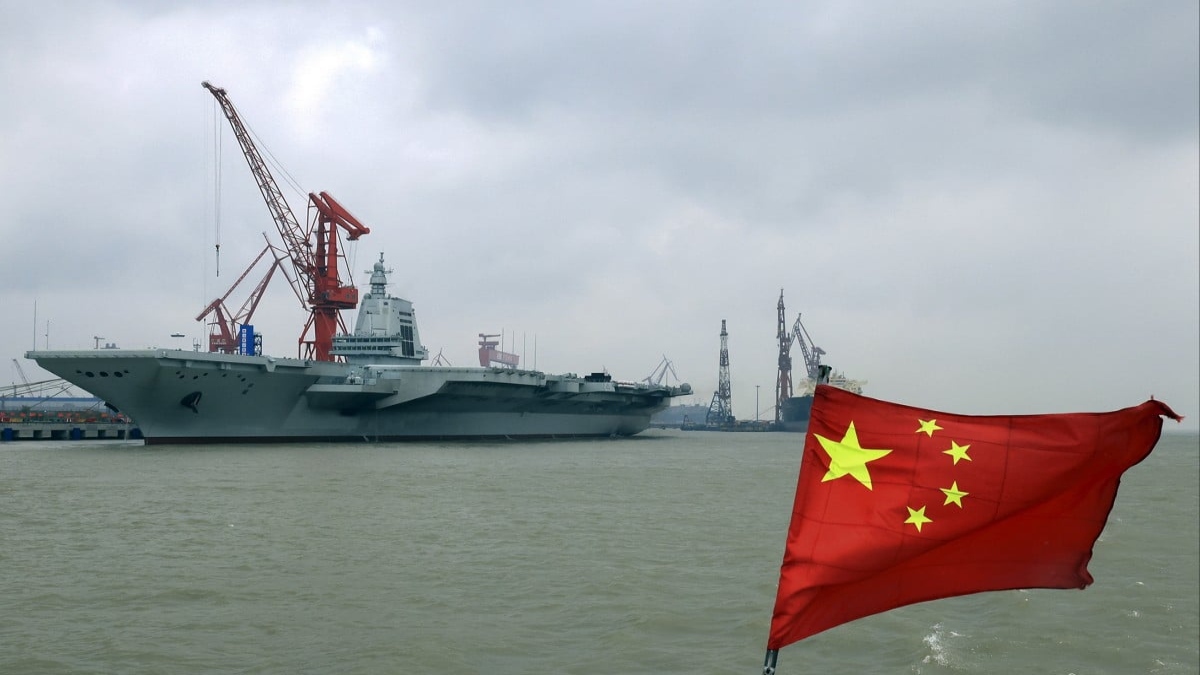China has claimed that the Fujian, country’s third aircraft carrier and its first built using a domestic design, is the world’s largest conventionally powered aircraft carrier.
In the first in-depth review of the vessel’s power and operating systems, according to a South China Morning Post report, citing state broadcaster CCTV, the warship had achieved something widely believed to be impossible by using an advanced electromagnetic catapult on a conventionally powered ship.
It had previously been thought that only nuclear-powered ships could generate enough electricity to launch aircraft using this technology.
“The Fujian is … currently the world’s largest known conventionally powered aircraft carrier by displacement,” South China Morning Post quoted CCTV as saying in a programme aired on Thursday.
“In a sense, the larger the carrier’s displacement, the greater its combat power,” it added.
Fujian boasts impressive features
When the Fujian was launched in June 2022, authorities had said its full load displacement – a key indicator of a ship’s carrying capacity, range, speed and manoeuvrability – was more than 80,000 tonnes. Its larger dimensions allow for increased aircraft capability.
Fujian has often been compared with the US Navy’s decommissioned Kitty Hawk-class supercarriers, the biggest of which was the USS America with a full load displacement of about 85,000 tonnes.
Impact Shorts
More ShortsHowever, the nuclear-powered USS Gerald R. Ford – which at over 100,000 tonnes leads the world in full load displacement – is the only other aircraft carrier on the planet today with this advanced ability.
Equipped with electromagnetic catapults, Fujian enables efficient and versatile aircraft launches, including heavier and more advanced aircraft types.
“The arrival of the Fujian has not only debunked, with its strength, the design theory that only nuclear-powered carriers can use electromagnetic catapults, but also elevated the combat capabilities of future domestically made carriers to another level,” South China Morning Post quoted CCTV as saying.
The CCTV programme also said that information regarding the new carrier-based aircraft for the Fujian will be released soon. It also showed the Fujian making a sharp turn, noting that the carrier had effectively reduced its wake, reducing the ability of enemy weapons to locate and attack the ship.
Complex design
According to the South China Morning Post, military analyst Cao Weidong told CCTV that the design of the Fujian was “much more complex” in some ways than that of its nuclear-powered peers, because it must ensure adequate electricity supplies for all devices.
He noted that the warship’s capabilities include increased aircraft capacity and the ability to launch fixed-wing early warning aircraft using electromagnetic catapults. This feature enhances airborne time, radar performance, and command capabilities.
Cao also pointed out that the electromagnetic catapult allows warplanes to take off with full fuel and ammunition, reducing reliance on refueling aircraft. This operational flexibility opens up space for additional drones, transport planes, and electronic warfare aircraft.
He said it would take up to two years to finish trials for the Fujian, adding: “The PLA Navy may build more aircraft carriers, potentially powered by nuclear energy.”
‘Substantial threat’ in South China Sea
The Fujian recently completed its second sea trial earlier this month, following an initial eight-day maiden voyage in May.
This naval activity has been interpreted as a demonstration of the People’s Liberation Army’s combat capabilities to stakeholders in both the South China Sea and East China Sea.
Meanwhile, the US Navy aircraft carrier Theodore Roosevelt arrived in South Korea on Saturday to participate in a three-nation exercise with Japan.
Last year, the three countries agreed to conduct annual joint drills during a summit where they collectively criticised China for its “dangerous and aggressive” actions in the South China Sea.
Taiwan’s defence ministry too has cautioned that the Fujian poses a significant threat in potential wartime scenarios.
China considers Taiwan an integral part of its territory and has not ruled out using force to reunify it. While most countries, including the United States, do not formally recognise Taiwan as an independent state, Washington opposes any coercive measures and supports Taiwan’s defence efforts.
With inputs from agencies
)